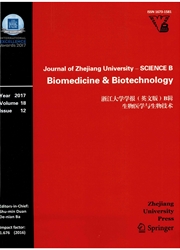

 中文摘要:
中文摘要:
肿瘤压制或 p53 是在人的肿瘤的最经常变异的基因。在压力条件下面,同时, p53 也充当一个抄写因素,调整维持染色体的完整的一系列目标基因的表达式。p53 的目标基因能被分类进调整房间周期拘捕,涉及 apoptosis 的基因,和禁止 angiogenesis 的基因的基因。p53 蛋白质包含一个 transactivation 领域,一个顺序特定的 DNA 有约束力的领域,一个 tetramerization 领域,认出损坏 DNA 的一个非特定的 DNA 有约束力的领域,和一个以后识别的充满脯氨酸的领域。在应力下面, p53 蛋白质通过二机制积累并且被激活。一个,包含混乱变异毛细管扩张的蛋白质(ATM ) ,是在 p53 之间的相互作用和它的下面规定因素鼠科的双分钟(MDM2 ) 2 减少,在 Ser15 上导致 p53 phosphorylation,,由 translational 以后机制决定了;p53 增加的另外的抓住并且通过 ribosomal 蛋白质 L26 (RPL26 ) 或 nucleolin 的绑定被激活到 p53 mRNA 5 ′ untranslated 区域(UTR ) ,调整 p53 翻译。在组织缺氧, p53 减少 transactivation 和增加 transrepression 下面。在 p53 的 DNA 有约束力的域外面的变化也贡献肿瘤进步,因此 p53 上的进一步的研究应该也集中于这个方向。在以色列的地下的盲目鼹鼠老鼠 Spalax 是为组织缺氧改编的一个好模型。Spalax 的 p53 在从精氨酸的残余 172 和残余 207 变异到离氨酸,交谈熬过 hypoxic 条件是能力。这个模型显示 p53 在进化期间充当差异形成的主人基因。
 英文摘要:
英文摘要:
Tumor suppressor p53 is the most frequently mutated gene in human tumors. Meanwhile, under stress conditions, p53 also acts as a transcription factor, regulating the expression of a series of target genes to maintain the integrity of genome. The target genes of p53 can be classified into genes regulating cell cycle arrest, genes involved in apoptosis, and genes inhibiting angiogenesis, p53 protein contains a transactivation domain, a sequence-specific DNA binding domain, a tetramerization domain, a non-specific DNA binding domain that recognizes damaged DNA, and a later identified proline-rich domain. Under stress, p53 proteins accumulate and are activated through two mechanisms. One, involving ataxia telangiectasia-mutated protein (ATM), is that the interaction between p53 and its down-regulation factor murine double minute 2 (MDM2) decreases, leading to p53 phosphorylation on Serl 5, as determined by the post-translational mechanism; the other holds that p53 increases and is activated through the binding of ribosomal protein L26 (RPL26) or nucleolin to p53 mRNA 5' untranslated region (UTR), regulating p53 translation. Under hypoxia, p53 decreases transactivation and increases transrepression. The mutations outside the DNA binding domain of p53 also contribute to tumor progress, so further studies on p53 should also be focused on this direction. The subter- ranean blind mole rat Spalax in Israel is a good model for hypoxia-adaptation. The p53 of Spalax mutated in residue 172 and residue 207 from arginine to lysine, conferring it the ability to survive hypoxic conditions. This model indicates that p53 acts as a master gene of diversity formation during evolution.
 同期刊论文项目
同期刊论文项目
 同项目期刊论文
同项目期刊论文
 期刊信息
期刊信息
